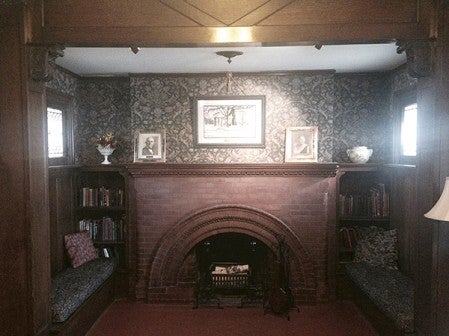Inglenook used for a variety of purposes
Published 5:10 pm Saturday, November 8, 2014
The Hormel Historic Home inglenook has been used for a variety of purposes lately.
It is always an attractive area that draws the eye, but recently it became the stage for an acoustic duo. On another occasion, it was a cozy space for sampling unique whiskey and cordials.
I am referring to the fireplace nook in the east room (the library) as you enter the Historic Home. There are many architectural features in the home that at one time served a purpose we may no longer recognize. Guests often point out a feature and ask or tell me about how the mechanism or attribute may have functioned.

Hormel Historic Home inglenook
This happened recently when a lady visited and her first words when entering the library were “an inglenook!” Apparently she had seen an episode on This Old House that featured a segment on these unique areas.
According to an article on www.thisoldhouse.com “The inglenook and the fireplace are the lineal descendants of the open fire once placed in the middle of medieval halls. There was no chimney and the hall would be always filled with smoke that flowed through unglazed windows. There was little loss of radiant heat but the inhabitants must have been very grubby. About the 12th century the fireplace was moved from its central location to a perimeter wall and eventually the fireplace began to be enclosed by side walls and covered with a smoke hood. The necessity for having a large hearth to burn big logs increased the size of collecting hoods and their supporting side walls in large, drafty common halls. The result was literally the building of little rooms within large ones. Those who cooked and tended the fire stood within the enclosed hearth. Soon, benches were placed on opposite sides so that additional family members could share the cozy space. The inglenook or “chimney corner,” had evolved, and saw its heyday throughout the middle ages. As families became more affluent, cold stonewalls were covered with wood paneling and tapestries. As rooms became more comfortable and fireplaces became more efficient, the inglenook was gradually reduced to decorative columns and pilasters. The trim that still surrounds our traditional fireplaces is symbolic of the inglenook — or “the little room inside a big room.”
As the Shingle-style cottage gained popularity in the late 1800s there was a revival of the inglenook chimney corner. “A medieval symbol for hearth and home, the inglenook was placed at the very core of the house,” according to the article.
The inglenook in the HHH was more likely a symbol of luxury rather than necessity, but it added a unique charm and warmth to our space. And it now works well for small musical groups or sharing hospitality.
History Happy Hour: Why History?
5:30-7:30 p.m., Nov. 10
Join us for happy hour-museum style. Enjoy light snacks and cocktails in an historic setting and learn about your community’s past. Social at 5:30 p.m.; presentation at 6 p.m. Panel of local history enthusiasts will discuss the importance of preserving history and sharing it with others. Free to members of the Austin Public Library, the Mower County Historical Society and the Hormel Historic Home. $5 for non-members. RSVP recommended. Call 507-433-4243.
Social Concerns: The Wartime Kitchen-Rationing during the World Wars
10 a.m. – 11 a.m., Nov. 18
Free event presented by Jaimie Timm of the Mower County Historical Society. Coffee and snack included.
Please call 507-433-4243 to reserve a spot.
Holiday Open House and Tea
1 p.m. and 4 p.m., Nov. 21-22
The HHH holiday tradition continues and you won’t want to miss it. Tour the 1871 home fully decorated for Christmas and enjoy a traditional tea menu. Musical entertainment will be featured in different parts of the home throughout the event.
Tickets are $15 and may be purchased at the door or in advance at www.hormelhistorichome.org.





